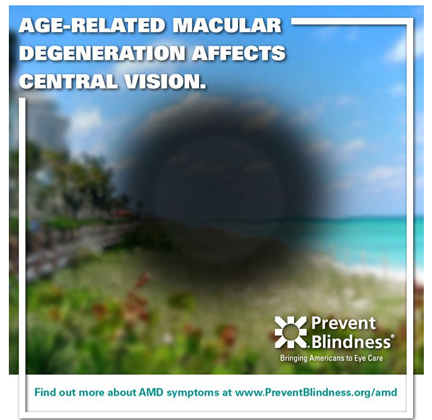
By Linda Conlin, Pro to Pro Managing Editor
The American Academy of Ophthalmology (AAO) has designated February as Age-related Macular Degeneration (AMD) Awareness month. It’s time to get ready to educate your patients and get the word out about this devastating eye disease. The National Institute of Health (NIH) defines AMD as a condition in which there is a slow breakdown of cells in the center of the retina. This blocks vision in the center of the eye and can cause problems with activities such as reading and driving. The American Macular Degeneration Foundation notes that AMD has become an epidemic. It’s the third leading cause of blindness worldwide, the leading cause of blindness in the U.S., twice as prevalent as Alzheimer’s, as prevalent as all forms of cancers combined, and primarily affects people over age 50. In spite of that prevalence, the Foundation notes that it is a disease that is little understood by the general public.
There are two forms of AMD. The dry form, in which parts of the macula get thinner with age and tiny clumps of protein called drusen grow. The patient will slowly lose central vision. According to the AAO, about 80% of the people who have AMD have the dry form, and there is no way to treat dry AMD yet. The other form is wet AMD. This form is less common but much more serious. Wet AMD is the condition in which new, abnormal blood vessels grow under the retina. These vessels may leak blood or other fluids, causing scarring of the macula. Patients lose vision faster with wet AMD than with dry AMD.
Risk factors for AMD include a diet high in saturated fat, overweight, smoking, over 50 years of age, hypertension, a family history of AMD, heart disease and high cholesterol levels. Caucasians also have an elevated risk of getting AMD. Many people don’t realize they have AMD until they have a vision problem.
While there is no treatment for dry AMD, studies have found that taking nutritional supplements may slow the progression of the disease. Those supplements include Vitamin C (500 mg), Vitamin E (400 IU), Lutein (10 mg), Zeaxanthin (2 mg), Zinc (80 mg) and Copper (2 mg). For wet AMD, there are medications called anti-VEGF drugs. The treatment helps reduce the number of abnormal blood vessels in the retina and slows leaking from blood vessels. This medicine is delivered to the eye through a very slender needle. Laser surgery is another treatment for some types of wet AMD.
To help educate your patients and community, Prevent Blindness offers AMD infographics and fact sheets as well as Guide Me, a free resource for those who have been recently diagnosed with AMD, their family members and caregivers. The National Eye Institute also offers flyers, booklets and other resources to print or download. So get the word out!
You can take an extra step by learning more about AMD and other causes of low vision, as well as optical aids to low vision with our CE, An Introduction to Low Vision, at 2020mag.com/ce.











